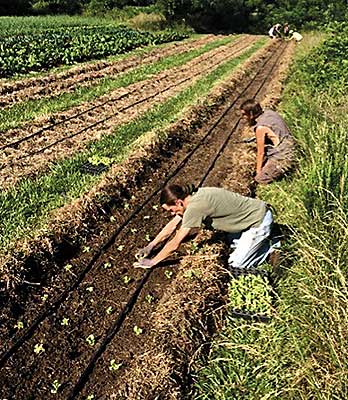 |
| Transplanting into a permanent bed at Foundation Farm. Note the mulch pulled to the shoulder of the bed, to compost in place. Photo courtesy of Foundation Farm |
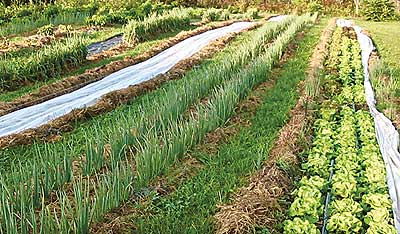 |
| Original pasture vegetation remains in the paths between beds at Foundation Farm. Photo courtesy of Foundation Farm |
Farming with no-till permanent beds can improve soil structure, reduce weeds, enable earlier planting dates, increase yields and rely less on expensive equipment. At MOFGA’s 2016 Farmer to Farmer Conference, four experts described their permanent bed farming.
Patrice Gros, Foundation Farm
Patrice Gros of certified organic Foundation Farm in northwest Arkansas (zone 6a) produces $80,000 to $90,000 yearly of over 25 types of vegetables and herbs on 24,000 square feet (about 1/2 acre) of permanent, unraised beds. He has five high tunnels: Three are 100 x 17 feet; one is 100 x 30; and one is 150 x 24. He sells at three weekly farmers’ markets, to the Ozark Natural Foods Co-op in Fayetteville and to a few restaurants. His net profit margin varies from 65 to 70 percent, and he has trained more than 70 farmers.
Gros’ inspiration for no-till came from Masanobu Fukuoka’s “The One-Straw Revolution” and “The Natural Way of Farming”; from Elaine Ingham, whose research “exploded the field of soil microbiology,” said Gros; and from “Teaming with Microbes: The Organic Gardener’s Guide to the Soil Food Web,” by Jeff Lowenfels and Wayne Lewis.
His no-till system is machine-free, he never steps on his beds, and his soil is never impacted except for occasional light raking and when pulling sweet potatoes. This avoids soil compaction and optimizes soil structure and microbiology, said Gros; and, in turn, maximizes accumulation of moisture, air and nutrients, which become available when plants need them. Dense plantings, cover crops, mulch, row covers and tunnels (“an amazing tool to protect the soil from compaction” because harsh rains are excluded) also contribute to or protect his soil structure. He likened his beds to a forest soil, which is never bare but is always protected by plants or mulch.
To create a bed, Gros mows an area, delineates 4-foot-wide beds and 3-foot-wide paths with string, digs a half-foot drainage ditch down the inside of each side of the beds, spreads manure at the rate of 1 pound per square foot on the beds, and then covers the beds with 1 foot of mulch. The mulch maintains high soil moisture; optimizes soil life; reduces irrigation needs; minimizes weeds, thus reducing or eliminating cultivation; and protects against compaction. Mulch can be straw, pine needles or wood chips, but not hay, fresh sawdust or plastic.
The year after starting a bed, he sets transplants through the mulch. The following year that bed is ready for direct-seeded crops.
Ten years ago, Gros bought 200 bales of straw mulch to cover his beds. The second year, 250 were needed. Now, after 10 years on this farm, he buys 600 bales (one bale per 50 square feet), suggesting that his soil is increasingly biologically active. Gros emphasized the importance of sourcing quality mulch by having a close relationship with the supplier and/or testing newly sourced mulch on a small area before using it extensively.
He continues to enrich his soil by adding rabbit manure (25 pounds per 100 square feet per year as a maintenance rate – although he is phasing this out because his soils don’t need it now), undersown cover crops (clover, soybeans), rotated cover crops (clover/oat, buckwheat/soybean), uncomposted crop residues, and grass clippings thrown from the paths onto the beds when he mows the paths. Feather meal supplies nitrogen for some crops.
His beds went from 1.6 percent organic matter 10 years ago to 9 percent now, and they have a pH of 7.2, which he believes is due to the alkaline bacterial mass. Because of the organic matter, he uses half as much water as other area farmers.
These beds are 100, 125 and 150 feet long, with paths remaining in original pasture species. He groups his beds into five zones of 6,000 square feet each, which he rotates, sowing one in cover crops for a full year (oats and clover followed by buckwheat and sorghum, followed by daikon radishes in fall). In November he adds 4 inches of mulch so that the bed is ready to be planted the following year. The zone in high tunnels is not rotated.
In the spring Gros rakes old mulch and decaying matter to the 1/2-food-wide inner shoulders of the beds to enable the soil to warm. This on-site composting reduces time spent moving and composting material. Two drip tapes with 4-inch emitters irrigate each bed.
He and a crew of two to six do all the field work on three mornings per week, from 7 a.m. to 12:30 or 1 p.m., averaging about 60 hours per week of labor. “Take composting and weeding out of the system,” said Gros. “Can you imagine the time saved?”
Beds hold four rows of lettuce heads or leeks; three rows of chard or cabbage; two rows of peppers or eggplant; or one row of sweet potatoes or squash. They produce two to three crops per year, averaging 55 cents worth of production per square foot per month in sales.
For example, in 2015, one 125-foot bed of cucumbers (not trellised) grossed $892 (500 square feet x 3.5 months x 51 cents/square foot/month = $892).
Using so much mulch means “I am still too big on inputs,” said Gros, adding that growing cover crops can reduce those inputs.
To watch a short video about Foundation Farm, see https://www.youtube.com/watch?v=7OrTKtBaW0c.
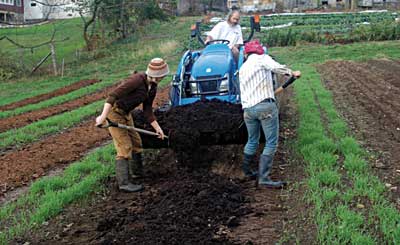 |
| Adding compost to permanent beds at Four Winds Farm. Photo courtesy of Four Winds Farm |
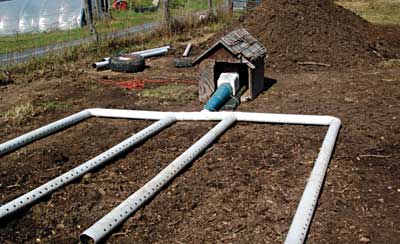 |
| One section of the compost aeration system at Four Winds Farm. Another section of perforated pipes will be added to extend the pile. A fan blows air into the pipes. Photo courtesy of Four Winds Farm |
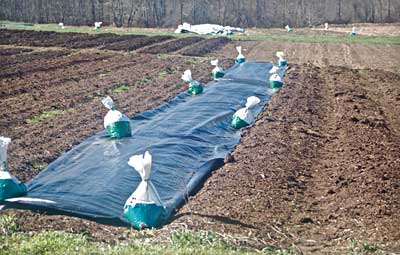 |
| Landscape fabric warms the soil at Four Winds Farm. Photo courtesy of Four Winds Farm |
Jay and Polly Armour, Four Winds Farm
Jay and Polly Armour have been cultivating their NOFA-certified organic Four Winds Farm in Gardiner, N.Y., since 1988. They use compost on their beds to control weeds and build soil organic matter, they have a “farm appropriate” composting system, and they’re experimenting with tarps to warm soil.
Most of their income comes from their 4-acre market garden, with the balance of their 24 acres in pasture. They sell at farmers’ markets and through their CSA. In 1993, farmers’ markets were declining in their area, so they switched to a CSA. In 2000 they returned to farmers’ markets, and in 2010 they split their CSA off from the farm as Second Wind to create a journeyperson experience, with interns from the previous year operating the CSA while using the Armours’ land, equipment, etc.
The Armours also raise blueberries and apples, 13 beef cows, turkeys and pigs.
They use permanent beds to build and maintain soil structure and to support a diverse soil biology; to promote drainage (including through micropores remaining when roots from the previous season decay), flocculation and tilth; to develop a high cation exchange capacity so that their soil holds nutrients; and to significantly decrease weed pressure because not tilling means not bringing new seeds up to germinate.
They built their second batch of beds in the late ‘90s by hiring a neighbor to plow and rototill the land. They then used a hiller disc to move soil from the pathways into the beds, so the beds are raised a little.
They spread compost in late October so that beds are ready to plant as early as possible in spring.
With permanent beds, inputs such as irrigation sprinklers can be placed where needed and can be placed precisely, said Polly.
They’ve created a productive intercropping technique by planting garlic in alternate beds in the fall, and in late spring planting winter squash in beds between the garlic beds. They mulch the squash heavily with straw. After garlic harvest in July, the squash runs over the former garlic beds.
A disadvantage to permanent beds, said Polly, is that some perennial weeds, such as Canada thistle, can be hard to eradicate if they become established. Also, grass sometimes creeps in from the edges, but a border of comfrey forms an impenetrable wall of roots that helps exclude that. Because they’re not rototilling, the comfrey doesn’t spread.
The Armours use cover crops that they can deal with easily by hand or that reliably winterkill, such as buckwheat, clovers and oats. To crimp more aggressive cover crops, Jay tied a bar from an old manure spreader onto a snowshoe (to displace his weight) and walks that bar down the bed, with his other foot remaining in the path. The bar spans the bed. He heard that a Pennsylvania farmer was using this method, and Jay is trying it with winter rye this year.
They raise cows in order to make a lot of compost. To speed and simplify composting, Jay developed an aeration system from four parallel, 4-inch, perforated drain pipes with caps on one end. An old fan (the type used in ductwork for air conditioning or heating) blows air through the pipes. Jay adapted its square opening to a round shape to connect to the pipes. A timer such as those used in hydroponic systems is set so that the blower runs for about three minutes and is then off for 20 minutes.
Jay drives a tractor to the pipes, covers the pipes with wood chips to help aerate the pile and to signal when his tractor bucket is close to the pipes, piles on manure from their cows and from a nearby horse farm, tops that with finished compost (because manure exposed to the air won’t reach the high temperatures needed) and then adds another length of piping. He now makes 30-foot-long compost piles. In summer the pile reaches 150 F within a day; in winter, within three days.
To spread compost on beds, two people shovel it from the tractor bucket as Jay backs the tractor up over each bed. The tractor wheels fit in the pathways between beds. On beds that have been mulched, they leave the mulch in place and apply compost on it in the fall. If they’re going to put transplants in the following spring, they leave the mulch and transplant through it. If they’re going to direct seed, they pull the mulch into the pathways and generally leave it there.
Recently the Armours tried using a 50- x 100-foot silage tarp, available from FarmTek, to warm soil. The tarp is black on one side and white on the other. It worked well, but picking it up before planting was difficult. They had to remove the water that collected where the tarp settled in the pathways before they could roll up the tarps. Then rolling up such a large piece was cumbersome.
They also tried using 6-foot-wide woven landscape fabric from Nolt’s Produce Supplies in Pennsylvania. A day after sowing peas in two beds, Jay covered one bed with landscape fabric and left it there for three days, which promoted earlier and better germination and resulted in twice the yield, although the peas in both beds produced at the same time.
Heirloom tomatoes are one of the Armours’ specialties and their main cash crop. Customers consistently tell them that their heirloom tomatoes taste better than other heirlooms grown in the same area.
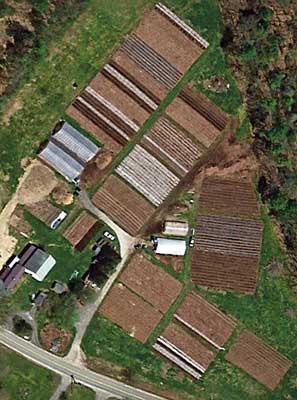 |
| Frith Farm is divided into 16 plots, each with 12 permanent beds that are 100 feet long each and are 5 feet on center. Photo courtesy of Frith Farm |
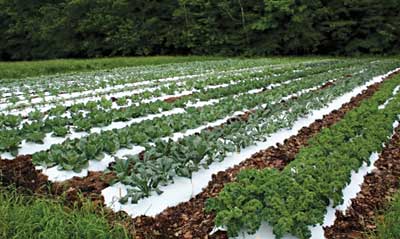 |
| For weed control, crops grow on plastic mulch the first year a bed is used. Note the leaf mulch in the paths. Photo courtesy of Frith Farm |
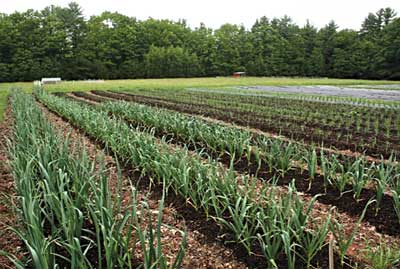 |
| Thriving garlic beds at Frith Farm. Photo courtesy of Frith Farm |
Daniel Mays, Frith Farm
Daniel Mays of MOFGA-certified organic Frith Farm in Scarborough, Maine, bought his land, house and 6-acre hay field six years ago, when he had about six months of farming experience. He now grows just over 3 acres of crops using compost and human power rather than tillage and with only a walk-behind tractor for mowing and initial bed shaping.
Mays grows more than 40 types of vegetables, more than 20 types of annual and perennial herbs, and, for his CSA customers, pick-your-own flowers. He sells eggs from 500 heritage breed laying hens raised on pasture and chicken from 500 heritage breed broilers raised on pasture and processed on-farm. (He plans to do 1,000 in 2017.) He raises 100 turkeys on pasture each year, processing them on-farm for Thanksgiving. About 50 heritage pigs are raised on pasture (but the butcher is not organic, so these are not certified organic). Mays’ lamb is 100 percent grass-fed but not certified organic; he sells raw and unfiltered honey (not certified organic) from the farm; and in 2016 he started raising shiitake and oyster mushrooms.
Markets in his Scarborough and greater Portland area include his 125-family CSA, natural food stores and other outlets. Between 2014 and 2016, his CSA sales went from 41 to 29 percent of his market, farmers’ markets went from 26 to 13 percent, while sales to natural foods stores increased from 17 to 38 percent of his market. Other, on-farm sales account for 10 percent of his market, and whole animal sales account for another 10 percent.
Mays stressed the importance of laying out modular plots – identical plots of equal-sized beds – to simplify planning, seed ordering, row cover length and rotations. He started with eight plots, each measuring 50 x 100 feet. Each plot had 10 beds of 100 feet, 5 feet on center, with paths about 18 inches wide. The farm now has 16 plots, each with 12 beds that are 100-feet-long each and are 5 feet on center.
Consider work flow, too, he said; locate the most commonly used infrastructure, such as a washing station, in the center of the farm. Use noodle diagrams: Trace your path around the farm for a day and try to get those noodles as short and few as possible. (Noodle diagrams are also called spaghetti diagrams. They use a continuous flow line to trace the path of an activity through a process.)
Only take on what you can do well, said Mays. Being on a tractor makes it easy to plow up extra ground and then not be able to manage that much land. Working with hand tools limits this.
Mays carefully constructs a crop plan in Excel and finalizes it each fall so that he spends no time planning during the busy growing season, so that seed orders are done by Christmas, and all decisions regarding rotations, successions, etc., are not made hastily. This plan becomes the record and can be used again the following year by moving plots around. He tries to allow a week or two between plantings so that, when a crop is done, he can flail mow it or, if it’s clean enough, rake it out, put a tarp on it for a week or two, then remove the tarp and plant.
To start a new bed in pasture, Mays turns the soil with a BCS rotary plow attachment (“Yes, this is tillage!” he said, noting that he practices one-time tillage followed by no-till), forms the raised beds, and then smothers perennial weeds with plastic mulch the first season and puts leaves in the paths. He has tried using just organic mulch to start beds, but so much mulch is needed to kill quackgrass that he wasn’t able to seed that area for a year or two.
From the second year on, he spreads 1 to 2 inches of compost (2 to 4 cubic yards of compost per 1,000 square feet or 90 to 180 cubic yards per acre, or according to a soil test) on the beds and plants into them. The compost provides nutrients and acts as a weed barrier.
To keep his tractor out of the field (even out of paths between beds), he spreads compost by setting three wheelbarrows at the head of a bed, scooping a 6-foot-wide bucket of compost with the tractor and dumping it into the three wheelbarrows (which, lined up, are 6 feet wide), and then three or four farmworkers walk the wheelbarrows down and dump the compost onto the beds.
In paths they spread 3 cubic yards of leaves per 1,000 square feet or 130 cubic yards per acre.
When covering beds and paths (in the fall, for instance, to protect the soil), they spread 6 cubic yards of leaves per 1,000 square feet or 260 cubic yards per acre. They either rake these leaves off the beds in the spring or plant right through them. Spreading too much mulch makes raking leaves off in spring too difficult and results in too deep a leaf layer in the paths; too little results in weeds growing through the mulch – weeds that can’t be hoed. The ideal depth covers the soil but is not much thicker than that.
On new plots, Mays dumped piles of compost here and there and let chickens spread them. In one plot that he opened, a tractor trailer dumped leaves, and Mays put pigs on it for half a season to spread them.
If crop planning, bed prep and mulching are done right, weeding needs should be minimal. When weeds do emerge, he uses colinear, stirrup and other types of hoes for annuals; a digging fork for dandelions, quackgrass, vetch and other perennials; and flame weeding after carrot seeding or for stale seed beds. When a crop is done, he mows it with a flail mower on a walking tractor, puts a tarp on the bed, and in a week or two the bed is weed-free. “Black tarps and time are a cure-all approach to weeding!” said Mays. He has over a dozen 20- x 60-foot vinyl tarps that cover three or four beds each. He sourced them Billboardtarps.com; its used billboard tarps are cheaper than silage tarps.
Mays cover crops almost exclusively with peas and oats because they winterkill. Direct seeded crops never follow these cover crops. He spreads compost directly on top of the residue in the spring and transplants into that. Likewise, widely spaced plants such as squash and tomatoes get planted into mulch that was spread the previous fall.
Mays grew his farm from 1 to 3.2 acres from 2011 to 2016, and revenue went from $26,158 to $190,000 in that same time – an increase from $0.60 to $1.36 per square foot. Over that time his soil organic matter moved from 3.7 to 6.6 percent. The farm had three fulltime workers in 2011 and now has seven.
– J E

